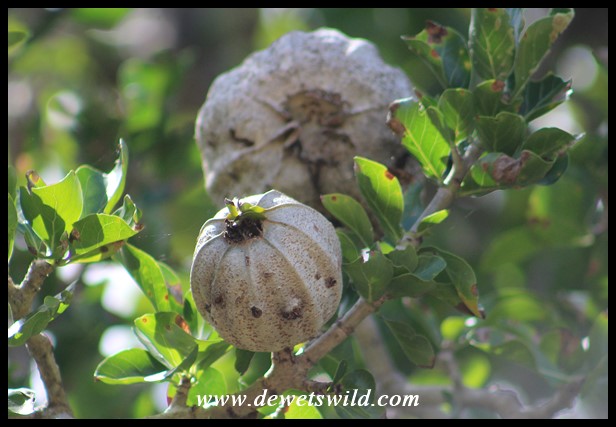Gardenia volkensii
The Bushveld Gardenia is a small to medium-sized shrub or tree growing to a height of up to 10m and with its spreading branches often reaching down to the ground. The large, white flowers (older flowers turn yellow) have a sweet aroma and are carried from July to December. They open at night and are probably pollinated by moths. The leaves of the Bushveld Gardenia are browsed by a wide range of animals, including giraffes and kudus. The hard fruit ripen between December and April and are favoured by primates, antelope and elephants.
In traditional medicine the Bushveld Gardenia is used to treat intestinal parasites, while the hard wood is used for carving ornaments and utensils.
The Bushveld Gardenia grows in savanna and open woodland and in South Africa occurs through much of Kwazulu-Natal, Mpumalanga, Limpopo, Gauteng and North West Province.











Like Anne I am more familiar with the G. thunbergia. The flowers last several days. We have a lovely specimen in our garden. Like the G. volkensii it also has very hard tough fruits but they are less ‘fluted’ in appearance – more like large oval eggs.
LikeLiked by 1 person
I imagine your gardenia tree is a focal point in the garden, Carol, especially when it is sporting such beautiful flowers? I would love to see just how an antelope or primate manages to open the hard fruit.
LikeLiked by 1 person
The plant is near the house and when it flowers the scent can be pretty overpowering. Yes it would be interesting to see animals eating the fruits. SANBI has an interesting entry on G. thunbergia saying the fruits don’t split or drop on their own but depend on large antelopes, buffalo and elephants (or botanists armed with hammers) to disperse the seeds!
LikeLiked by 1 person
Giggling at the botanists armed with hammers insert! 😀
LikeLiked by 1 person
🙂
LikeLiked by 1 person
baie interessant
LikeLiked by 1 person
Soos alles in die natuur mos maar is, Elsabe!
LikeLiked by 1 person
Ek kan nie se dat ek al hierdie boom gesien het nie (veral as ek na die vruggie kyk). Maar hoe mooi is die blommetjie … ek vind dit baie interessant dat dit net snags oop is.
LikeLiked by 1 person
Ek sou graag wou sien hoe lyk die motte wat die blomme bevrug, Corna, en hoe hulle dit doen.
LikeLiked by 1 person
I don’t quite understand why the beauty of any gardenia would be lost because it is only open at night.
LikeLike
I think it is a fascinating quirk that these plants “break the mould” so to speak so that they can be pollinated by nocturnal wildlife instead!
LikeLike
This is fascinating for me as I am only familiar with the Gardenia thunbergia or witkatjiepiering that grows in this region. One might be fooled by the similar looking flowers, yet I note a distinct difference between their fruit.
LikeLiked by 1 person
Does the Witkatjiepiering also only open its flowers at night, Anne?
LikeLike
I have seen them open during the day.
LikeLiked by 1 person
Very interesting!
LikeLike
An attractive tree with a pretty bloom.
LikeLiked by 1 person
Pity the flowers are only open at night!
LikeLike
🥲
LikeLike